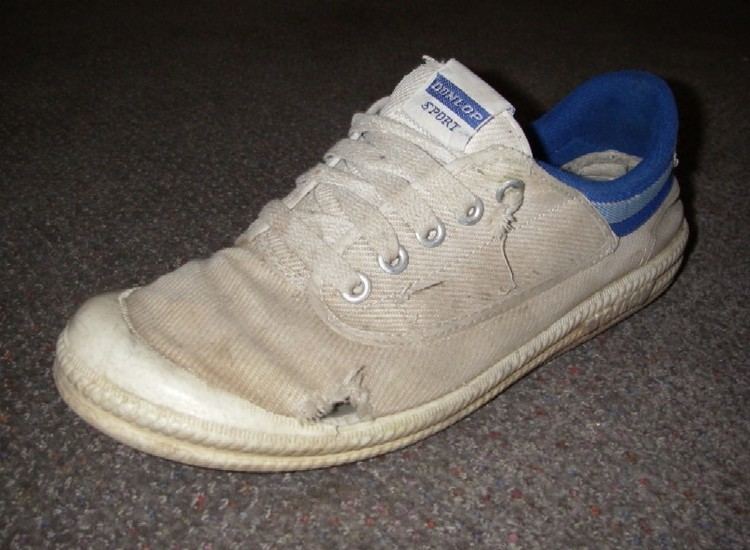Launch year 1939 | ||
 | ||
Company Brand Collective Pty Ltd (owned by Anchorage Capital) | ||
Dunlop Volley, now just Volley, is a brand of sandshoe that used to be very popular in Australia, similar to the Plimsoll shoe. It was produced by Dunlop Sport (Australia), part of Pacific Brands which separated the Volley brand into its Brand Collective Pty Ltd which was sold to private equity firm Anchorage Capital Partners in November 2014. As of January 2014, some models appear to have resumed standards of grip and wear that are comparable to the quality of previous decades.
Contents
The shoe is constructed of cotton canvas with a thermoplastic rubber sole. It was introduced by Dunlop Australia in 1939, and has had only minor changes to its design since then. Originally plain white in colour, a green and gold stripe was added to the heel in the 1970s. Today, the standard design is white with a 3-stripe woven tape on the heel, while the green and gold stripe, and an all-black version, are also available.
In 1939, the Volley OC was released In the 1970s, Dunlop released a new style of Volley named the Volley International. The new model featured a new design upper and injection moulded rubber sole. From 1978 to 1985, there was a large volume of sales of the Volley in Australia. It became virtually the standard tennis shoe, and was also popular with roofers, who needed a sure foothold on sloping roof surfaces.
During the early 1980s, Dunlop briefly released a 'basketball boot' version of the Volley International which covered the ankle. These shoes, which had the high-grip herringbone tread, were highly prized by rafters and bushwalkers, who appreciated the dissipation of the friction point at the heel, the reduced entry of sand and debris, and the protection to the ankles against knocks from rocks when wading in rapids. The cotton canvas around the ankle was a seamless extension of the Volley's uppers; it did not seek to 'support' the ankle, only protect it. However, the boot was unavailable by 1983.
In 1998, Dunlop Footwear moved production offshore and in 2004, Dunlop Sport became part of the Pacific Brands group. By 2012, changes to the Dunlop Volley had led to many bushwalkers and roofing contractors concluding that the new shoes are no longer adequate, and that Dunlop had failed to rectify the situation.
In 2013, Dunlop started to revise the "Volley International" back to its 1970s version. The classic "early 1980s basketball boot" Volley also returned, as the "Volley High Leap". These and other variants became available for internet sale from Dunlop Volley's official sales website, www.volley.com.au.
Usage of the Dunlop Volley
The Volley was originally developed in 1939 as a tennis shoe by Adrian Quist, a famous Australian tennis player & employee of Dunlop. Adrian borrowed a pair of boat shoes (with Herringbone sole) during his Davis Cup tournament win in the USA and upon his return, convinced Dunlop to develop this high grip sports shoe. The original shoe was called the Volley OC (Orthopaedically Correct) and was worn by Rod Laver, Margaret Court, Evonne Goolagong Cawley, Ken Rosewall etc. The Volley OC continued up until the 1970s when it was replaced by the Volley International which featured the 3 stripe woven tape around the heel, side quarter panels which secure the tongue, and new look injection moulded rubber sole.
In 1976 Mark Edmondson won the Australian Open catapulting the Volley back into the spotlight.
The distinctive herringbone tread is famous for its excellent grip, making the shoe a favourite among roofers, canyoners, and parkour practitioners. The popularity with tradespeople led to the development of Volley Safety shoes with steel caps to meet work site safety requirements.
Dunlop Volleys were standard issue by the Australian Army and Royal Australian Air Force until the late 1980s, and are still issued by the Royal Australian Navy, although sometimes the Spalding imitation shoe is substituted.
A pair of Volleys subjected to prolonged wear and tear will develop two distinctive holes. Firstly, where the canvas meets the rubber sole at the big toe, and secondly, at the widest part of the shoe where the little toe will subsequently be exposed.
2012 Australian Olympics team
In March 2011, the Australian Olympic Committee announced that the Dunlop Volley would be included as part of the Australian Olympics team's official uniform for the 2012 Summer Olympics.
